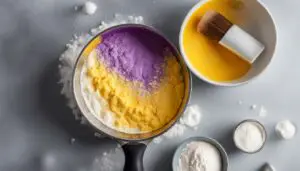Originally posted on December 13, 2023 @ 9:23 pm
Are you looking for a substitute for buttermilk in your recipes? Whether you’re out of buttermilk or following a specific dietary plan, there are plenty of alternatives to choose from. In this article, we’ll explore various options for replacing buttermilk in recipes, providing you with simple swaps that can maintain the texture and flavor of your favorite baked goods.
Contents
- 1 Dairy-Based Buttermilk Substitutes
- 2 Buttermilk Powder and Water
- 3 Dairy-Free, Vegan Substitutes
- 4 Low Carb, Paleo-Friendly Buttermilk Substitutes
- 5 Simple Homemade Buttermilk Substitute
- 6 Store-Bought Buttermilk Substitutes
- 7 Tips for Storing Buttermilk Substitute
- 8 Benefits of Using Buttermilk Substitutes
- 9 Try It Today – Recipe Recommendation
- 10 Conclusion
- 11 FAQ
- 11.1 Can I substitute buttermilk in a recipe?
- 11.2 What are the dairy-based buttermilk substitutes?
- 11.3 How can I replace buttermilk in baking?
- 11.4 Are there non-dairy substitutes for buttermilk?
- 11.5 What are some low carb, paleo-friendly buttermilk substitutes?
- 11.6 How can I make a simple homemade buttermilk substitute?
- 11.7 Are there store-bought buttermilk substitutes available?
- 11.8 How can I store leftover buttermilk substitute?
- 11.9 What are the benefits of using buttermilk substitutes?
- 11.10 Can you recommend a recipe to try with a buttermilk substitute?
- 12 Source Links
Key Takeaways:
- There are several dairy-based substitutes for buttermilk, such as milk and vinegar, milk and lemon juice, and more.
- Non-dairy alternatives like yogurt and water or non-dairy milk and acid can also be used as substitutes for buttermilk.
- Buttermilk powder mixed with water can create a liquid buttermilk substitute.
- For vegan or dairy-free options, you can use unsweetened soy milk, vegan sour cream, or plant-based milks with acid.
- Low-carb and paleo-friendly substitutes include unsweetened coconut milk, almond milk, or cashew milk with acid.
Dairy-Based Buttermilk Substitutes
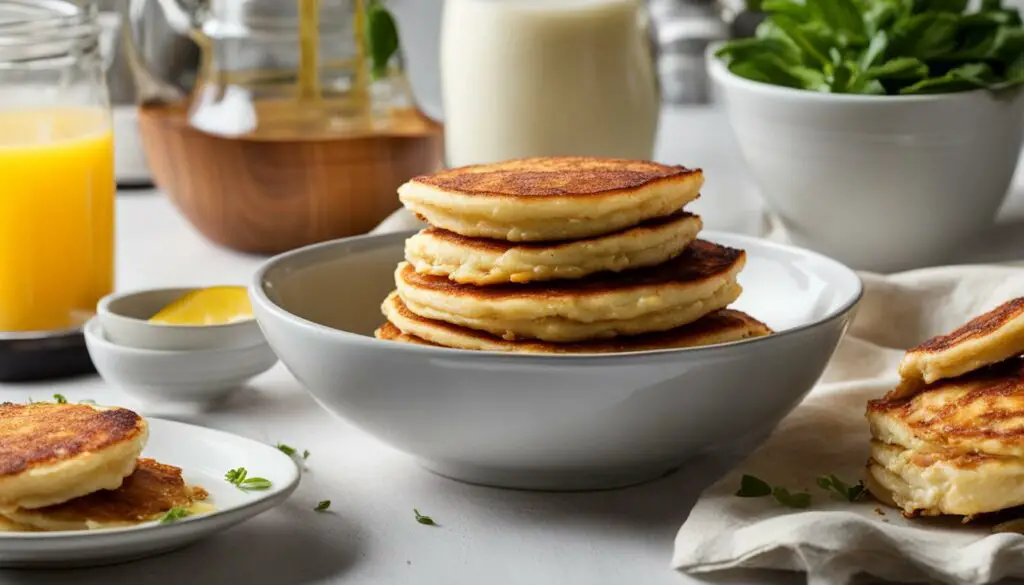
If you prefer using dairy-based substitutes for buttermilk in your cooking, there are several options available that can easily replace buttermilk in your recipes. These alternatives not only mimic the texture and tanginess of buttermilk but also provide a similar taste and consistency to your dishes. Here are some dairy-based buttermilk substitutes that you can try:
- Milk and Vinegar: Mix 1 cup of milk with 1 tablespoon of vinegar. Let it sit for 5 minutes until it thickens and curdles slightly.
- Milk and Lemon Juice: Combine 1 cup of milk with 1 tablespoon of lemon juice. Allow it to sit for a few minutes until it thickens and curdles slightly.
- Milk and Cream of Tartar: Mix 1 cup of milk with 1.75 teaspoons of cream of tartar. Stir well until the cream of tartar dissolves.
- Lactose-Free Milk and Acid: Substitute regular milk with lactose-free milk and add acid, such as vinegar or lemon juice, in a 1:1 ratio.
- Sour Cream and Water or Milk: Dilute 3/4 cup of sour cream with 1/4 cup of water or milk to achieve a buttermilk-like consistency.
- Plain Yogurt and Water or Milk: Mix 3/4 cup of plain yogurt with 1/4 cup of water or milk to create a suitable substitute for buttermilk.
- Plain Kefir: Use plain kefir as a one-to-one replacement for buttermilk in your recipes.
These dairy-based buttermilk substitutes can be used in equal amounts as a replacement for buttermilk in your cooking. They provide a similar tangy flavor and help maintain the desired moisture and texture of your dishes. Whether you’re making pancakes, cakes, or biscuits, these alternatives ensure that you can enjoy your favorite recipes even without traditional buttermilk.
Buttermilk Powder and Water

If you don’t have any buttermilk on hand, another option for a buttermilk substitute is to use buttermilk powder. This dehydrated powder can be reconstituted with water to create a liquid buttermilk substitute.
Here’s how you can easily make your own buttermilk substitute using buttermilk powder:
- Mix about 1/4 cup of powdered buttermilk with 1 cup of water.
- Stir the mixture until the powder is fully dissolved, creating a smooth liquid.
By following these steps, you’ll yield 1 cup of buttermilk substitute, ready to be used in your recipes.
Dairy-Free, Vegan Substitutes
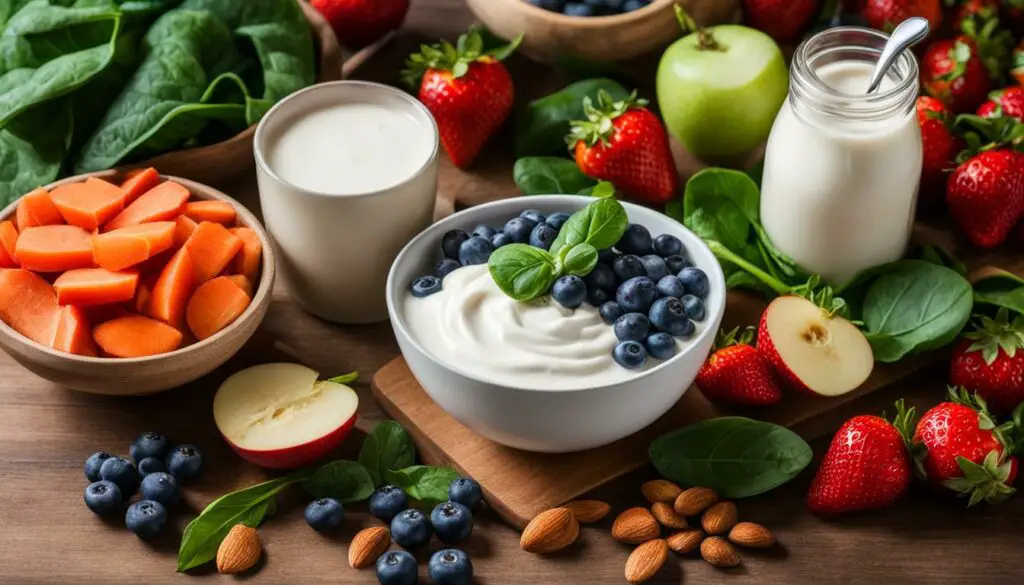
For those who follow a dairy-free or vegan lifestyle, there are several plant-based options for buttermilk substitutes. You can use unsweetened soy milk and acid, vegan sour cream and water, tofu, water, and acid, unsweetened coconut milk and acid, unsweetened almond milk and acid, or unsweetened cashew milk and acid. These combinations provide the same tangy flavor and thick texture as buttermilk, but without the dairy.
Low Carb, Paleo-Friendly Buttermilk Substitutes
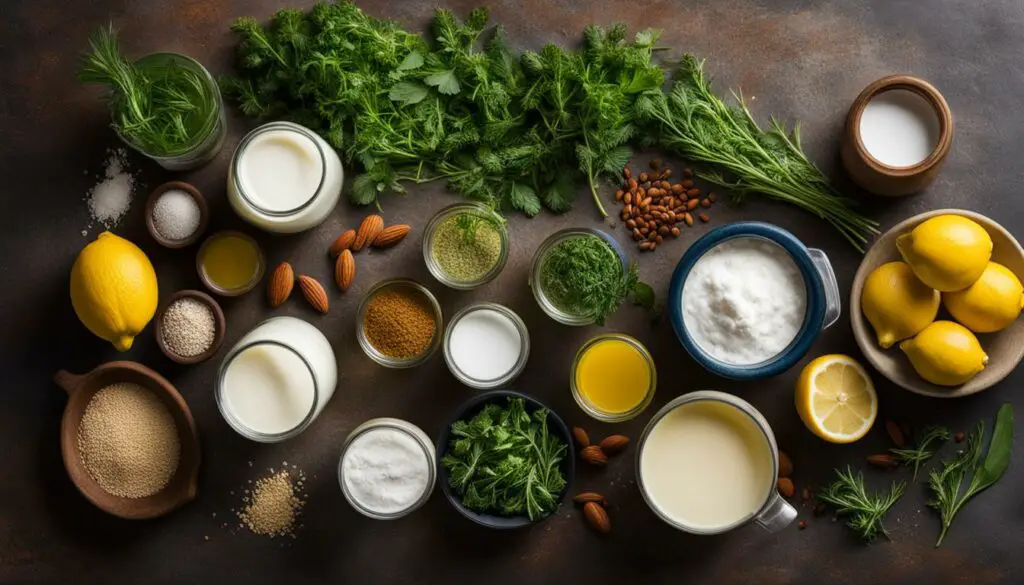
If you’re following a low carb or paleo diet, you may be wondering how to replace buttermilk in your recipes. Luckily, there are several options available that are both low in carbs and paleo-friendly.
One great choice is to use unsweetened coconut milk and acid. The natural richness of coconut milk provides a creamy texture, while the acid, such as vinegar or lemon juice, adds a tangy flavor. This combination is perfect for those looking to add a tropical twist to their recipes.
Another option is unsweetened almond milk and acid. Almond milk has a subtle nutty flavor and creamy consistency, making it a versatile substitute for buttermilk. Pair it with a touch of vinegar or lemon juice to achieve that characteristic tanginess.
For a slightly different flavor profile, consider unsweetened cashew milk and acid as a substitute for buttermilk. Cashew milk has a creamy texture with a hint of sweetness, balancing perfectly with the acid to provide a tangy and satisfying alternative.
To help you visualize the differences between these low carb, paleo-friendly substitutes, here’s a comparison table:
| Substitute | Description | Taste | Texture |
|---|---|---|---|
| Unsweetened Coconut Milk and Acid | Full-bodied and creamy | Distinct coconut flavor with tanginess | Rich and velvety |
| Unsweetened Almond Milk and Acid | Smooth and nutty | Subtle nuttiness with tanginess | Light and slightly thin |
| Unsweetened Cashew Milk and Acid | Silky and mildly sweet | Mild sweetness with tanginess | Creamy and luscious |
Experiment with these low carb, paleo-friendly buttermilk substitutes in your recipes and discover your favorite flavor combination. Whether you choose the tropical richness of coconut milk, the nutty undertones of almond milk, or the silky smoothness of cashew milk, you’ll be able to enjoy the same tangy goodness without compromising your dietary goals.
Simple Homemade Buttermilk Substitute
If you don’t have any of the specific ingredients mentioned above, you can make a simple homemade buttermilk substitute using just two ingredients – milk and vinegar or lemon juice. Just add 1 tablespoon of vinegar or lemon juice to 1 cup of milk, stir, and let it sit for 5 minutes. The acidity of the vinegar or lemon juice will curdle the milk slightly, creating a substitute with a similar tangy flavor and texture as buttermilk.
This simple homemade buttermilk substitute is perfect for those times when you run out of buttermilk or need a dairy-free option. It’s quick, easy, and uses ingredients you likely already have in your pantry. Whether you’re making pancakes, biscuits, or a delicious buttermilk cake, this substitute will provide the same tangy goodness as traditional buttermilk.
Here’s a step-by-step guide to making the homemade buttermilk substitute:
- Pour 1 cup of milk into a measuring cup or bowl.
- Add 1 tablespoon of vinegar or lemon juice to the milk.
- Stir the mixture gently until well combined.
- Let the mixture sit for 5 minutes to allow it to curdle slightly.
- Your homemade buttermilk substitute is now ready to use in your favorite recipes!
This substitute works best in recipes that call for buttermilk as a liquid ingredient. Its tangy flavor and slightly thickened texture make it an excellent replacement in pancakes, waffles, cakes, biscuits, and even marinades. Feel free to experiment with different recipes and enjoy the same great taste and texture of buttermilk without needing to make a trip to the store.
So next time you find yourself without buttermilk but still want to create that perfect baked good or flavorful dish, don’t worry! You can easily whip up a homemade buttermilk substitute using milk and vinegar or lemon juice. It’s a convenient and delicious solution that will allow you to keep cooking and baking without skipping a beat!
Store-Bought Buttermilk Substitutes
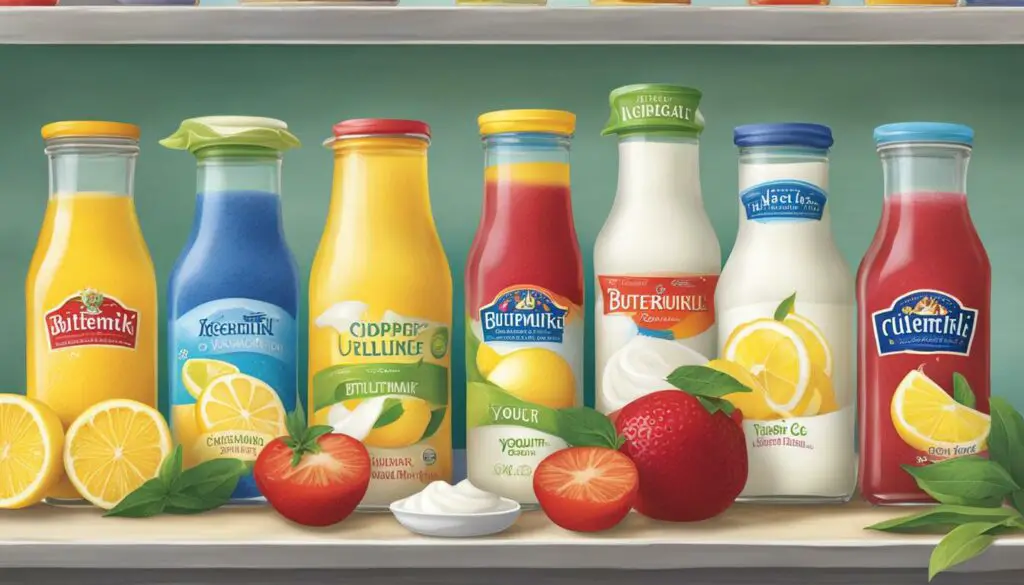
If you prefer the convenience of store-bought substitutes, there are also options available. Many grocery stores carry pre-made buttermilk substitutes in the dairy or baking aisle. These substitutes are specifically formulated to mimic the taste and texture of buttermilk and can be used as a 1:1 replacement in your recipes.
Store-bought buttermilk substitutes offer a convenient solution for those who may not have the time or ingredients to make their own substitutes at home. They come in liquid form, typically packaged in cartons or bottles, making it easy to measure and pour. These substitutes are designed to provide the same tanginess and thickness as traditional buttermilk, ensuring your recipes turn out just as delicious.
The advantage of using store-bought substitutes is that they are readily available and can save you time in the kitchen. You don’t have to worry about curdling milk, mixing ingredients, or leaving them to sit before using them. Simply grab a container of the pre-made substitute, measure out the required amount, and incorporate it into your favorite recipes. It’s a hassle-free option that yields consistent results.
When selecting a store-bought buttermilk substitute, be sure to read the labels carefully to ensure it meets your dietary needs and preferences. Some substitutes may be dairy-based, while others may be plant-based or vegan-friendly. Choose the one that aligns with your lifestyle and desired flavor profile.
Remember that store-bought substitutes may vary in taste and consistency compared to homemade alternatives. It’s a good idea to experiment with different brands to find the one that best suits your palate and recipe requirements.
Now, let’s take a look at a table comparing some popular store-bought buttermilk substitutes:
| Store-Bought Buttermilk Substitute | Main Ingredients | Use as 1:1 Replacement? |
|---|---|---|
| Brand A Buttermilk Substitute | Milk, acidifiers, stabilizers | Yes |
| Brand B Buttermilk Substitute | Dairy-free milk, acidifiers, thickeners | Yes |
| Brand C Buttermilk Substitute | Plant-based milk, emulsifiers, flavorings | Yes |
Please note that this is just a sample table and is not exhaustive. The availability and specific details of store-bought buttermilk substitutes may vary depending on your location and the brands carried by your local stores.
As you can see, there are several options to choose from when it comes to store-bought buttermilk substitutes. So, the next time you need a quick and easy replacement for buttermilk in your recipes, consider picking up a pre-made substitute from your local grocery store.
Tips for Storing Buttermilk Substitute
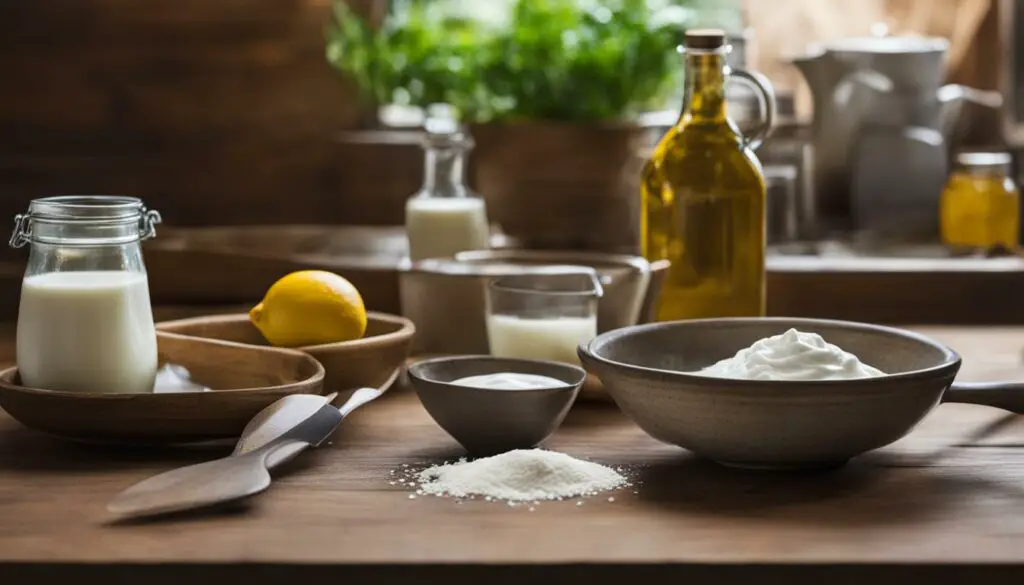
If you have successfully made a buttermilk substitute and find yourself with leftovers, it’s important to know how to store it properly to ensure its freshness and usability. Here are a few tips on storing your homemade buttermilk substitute:
- Transfer the buttermilk substitute to an airtight container: Once you have made the buttermilk substitute, transfer it to a clean, airtight container. This will help prevent any contamination or moisture from entering and affecting its quality.
- Refrigerate for up to two weeks: The buttermilk substitute can be stored in the refrigerator for up to two weeks. Make sure the refrigerator temperature is set to the appropriate level (around 40°F or 4°C) to maintain its freshness and prevent spoilage.
- Label the container or bag: To avoid confusion, label the container or bag with the measurement of the buttermilk substitute. This will make it easier for you to identify the quantity when you need it for future recipes.
- Freeze in ice cube trays for long-term storage: If you have more buttermilk substitute than you need, consider freezing it in ice cube trays. This allows you to portion it out and use smaller quantities as needed. Once frozen, transfer the buttermilk substitute cubes to a freezer bag or container for long-term storage.
- Thaw frozen buttermilk substitute: When you’re ready to use the frozen buttermilk substitute, simply thaw the desired number of cubes in the refrigerator overnight. Avoid thawing at room temperature to prevent the growth of harmful bacteria.
With these simple storage tips, you can make the most out of your buttermilk substitute and ensure it remains fresh and ready to use whenever you need it.
See the table below for a quick summary of the storage tips:
| Storage Tips for Buttermilk Substitute |
|---|
| Transfer the buttermilk substitute to an airtight container |
| Refrigerate for up to two weeks |
| Label the container or bag with the measurement |
| Freeze in ice cube trays for long-term storage |
| Thaw frozen buttermilk substitute in the refrigerator overnight |
Benefits of Using Buttermilk Substitutes
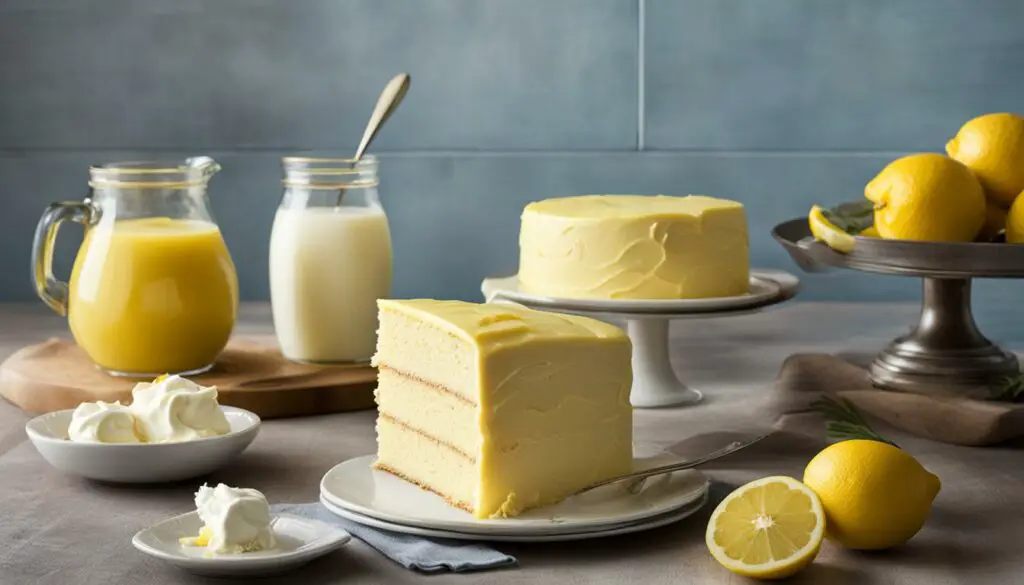
Using buttermilk substitutes in your recipes can have several benefits. They allow you to still enjoy the light and moist texture that buttermilk provides, even if you don’t have any on hand. They also allow those with dietary restrictions or allergies to still enjoy the flavors of buttermilk in their favorite dishes. Additionally, making your own buttermilk substitute can save you money and reduce food waste.
When you replace buttermilk with a suitable substitute, you can achieve similar taste and texture results. This is especially beneficial for those who follow specific diets or have dietary sensitivities. By using a buttermilk substitute, you can tailor your recipes to meet your individual needs without sacrificing flavor or texture.
Furthermore, creating your own buttermilk substitute is a cost-effective alternative. Instead of purchasing buttermilk for a single recipe and potentially wasting the remainder, you can easily make a substitute using ingredients you may already have in your pantry. This not only saves you money but also reduces food waste, aligning with sustainable cooking practices.
Whether you run out of buttermilk or simply prefer an alternative option, using a buttermilk substitute allows you to continue baking and cooking your favorite recipes without compromise. Experimenting with different substitutes can open up a world of culinary possibilities, making it easier to accommodate dietary needs and preferences while still achieving delicious results.
Explore the table below for a summary of the key benefits of using buttermilk substitutes:
| Benefits of Using Buttermilk Substitutes |
|---|
| Allows you to enjoy light and moist texture in recipes |
| Provides options for those with dietary restrictions or allergies |
| Saves money and reduces food waste |
Try It Today – Recipe Recommendation
Now that you know how to make buttermilk substitutes, why not try it out in a recipe today? One great option is to use the buttermilk substitute in a classic southern cornbread recipe. Cornbread pairs well with a variety of savory dishes and the buttermilk substitute will give it that extra touch of flavor and tenderness. Check out some recipe ideas online and get cooking!
Conclusion
In conclusion, when it comes to substituting buttermilk in recipes, you have a wide range of options to choose from. Whether you prefer dairy-based substitutes or non-dairy alternatives, there are plenty of ingredients that can provide the same tangy flavor and moisture to your favorite recipes.
For those who enjoy dairy, using combinations of milk and acidic ingredients like vinegar, lemon juice, or cream of tartar can easily replace buttermilk. Sour cream, plain yogurt, or kefir are also excellent dairy-based options.
If you follow a dairy-free or vegan lifestyle, plant-based milks such as soy milk, coconut milk, almond milk, or cashew milk paired with acid can create a suitable buttermilk substitute.
Experiment with these different substitutes to find the ones that best meet your dietary needs and preferences. With the wide range of options available, you can enjoy the same great flavor and texture in your favorite recipes without relying on buttermilk.
FAQ
Can I substitute buttermilk in a recipe?
Yes, there are several alternatives you can use as a substitute for buttermilk in recipes.
What are the dairy-based buttermilk substitutes?
Some dairy-based options include milk and vinegar, milk and lemon juice, milk and cream of tartar, lactose-free milk and acid, sour cream and water or milk, plain yogurt and water or milk, or plain kefir.
How can I replace buttermilk in baking?
You can use buttermilk powder mixed with water or mix milk and vinegar or lemon juice to create a substitute for buttermilk in baking.
Are there non-dairy substitutes for buttermilk?
Yes, you can use unsweetened soy milk and acid, vegan sour cream and water, tofu, water, and acid, unsweetened coconut milk and acid, unsweetened almond milk and acid, or unsweetened cashew milk and acid as non-dairy alternatives to buttermilk.
What are some low carb, paleo-friendly buttermilk substitutes?
Unsweetened coconut milk and acid, unsweetened almond milk and acid, or unsweetened cashew milk and acid can be used as low carb, paleo-friendly alternatives to buttermilk.
How can I make a simple homemade buttermilk substitute?
Mix 1 tablespoon of vinegar or lemon juice with 1 cup of milk, stir, and let it sit for 5 minutes to create a simple homemade buttermilk substitute.
Are there store-bought buttermilk substitutes available?
Yes, there are pre-made buttermilk substitutes available in many grocery stores’ dairy or baking aisles.
How can I store leftover buttermilk substitute?
Store the leftover buttermilk substitute in an airtight container in the refrigerator for up to two weeks, or freeze it in ice cube trays for later use.
What are the benefits of using buttermilk substitutes?
Using buttermilk substitutes allows you to enjoy the same texture and flavor in your recipes, even if you don’t have access to buttermilk. They also cater to dietary restrictions or allergies and can help reduce food waste.
Can you recommend a recipe to try with a buttermilk substitute?
A classic southern cornbread recipe pairs well with buttermilk substitutes, providing extra flavor and tenderness. Look up some recipe ideas online and get cooking!




